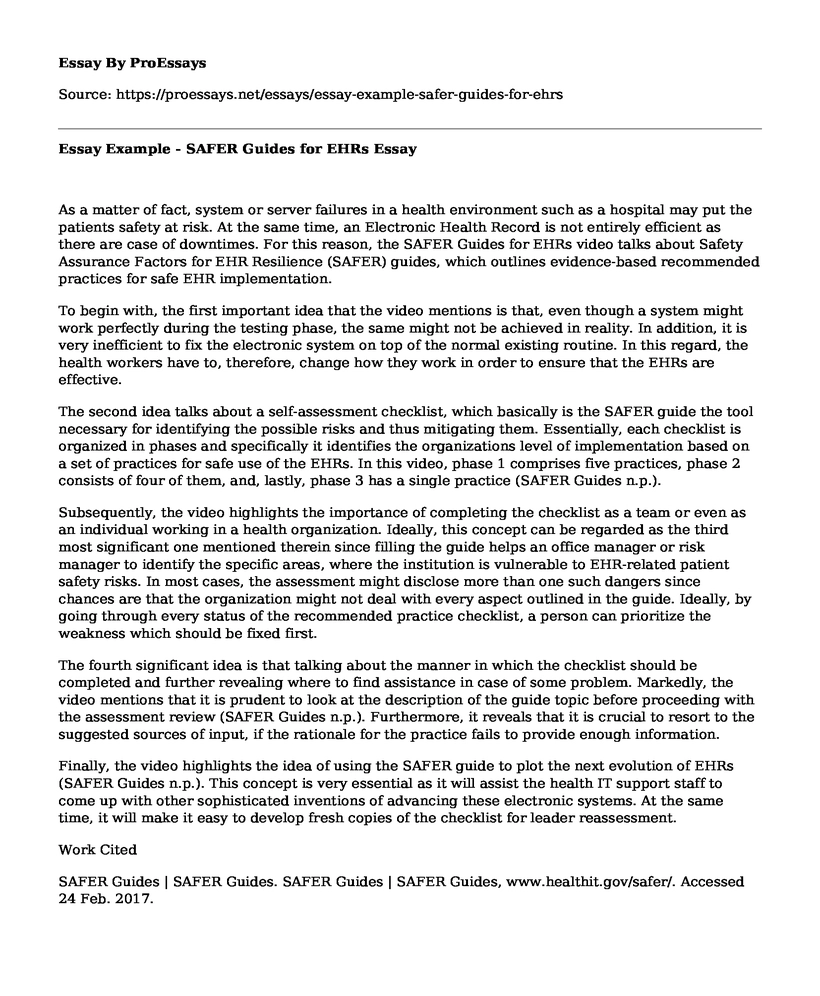As a matter of fact, system or server failures in a health environment such as a hospital may put the patients safety at risk. At the same time, an Electronic Health Record is not entirely efficient as there are case of downtimes. For this reason, the SAFER Guides for EHRs video talks about Safety Assurance Factors for EHR Resilience (SAFER) guides, which outlines evidence-based recommended practices for safe EHR implementation.
To begin with, the first important idea that the video mentions is that, even though a system might work perfectly during the testing phase, the same might not be achieved in reality. In addition, it is very inefficient to fix the electronic system on top of the normal existing routine. In this regard, the health workers have to, therefore, change how they work in order to ensure that the EHRs are effective.
The second idea talks about a self-assessment checklist, which basically is the SAFER guide the tool necessary for identifying the possible risks and thus mitigating them. Essentially, each checklist is organized in phases and specifically it identifies the organizations level of implementation based on a set of practices for safe use of the EHRs. In this video, phase 1 comprises five practices, phase 2 consists of four of them, and, lastly, phase 3 has a single practice (SAFER Guides n.p.).
Subsequently, the video highlights the importance of completing the checklist as a team or even as an individual working in a health organization. Ideally, this concept can be regarded as the third most significant one mentioned therein since filling the guide helps an office manager or risk manager to identify the specific areas, where the institution is vulnerable to EHR-related patient safety risks. In most cases, the assessment might disclose more than one such dangers since chances are that the organization might not deal with every aspect outlined in the guide. Ideally, by going through every status of the recommended practice checklist, a person can prioritize the weakness which should be fixed first.
The fourth significant idea is that talking about the manner in which the checklist should be completed and further revealing where to find assistance in case of some problem. Markedly, the video mentions that it is prudent to look at the description of the guide topic before proceeding with the assessment review (SAFER Guides n.p.). Furthermore, it reveals that it is crucial to resort to the suggested sources of input, if the rationale for the practice fails to provide enough information.
Finally, the video highlights the idea of using the SAFER guide to plot the next evolution of EHRs (SAFER Guides n.p.). This concept is very essential as it will assist the health IT support staff to come up with other sophisticated inventions of advancing these electronic systems. At the same time, it will make it easy to develop fresh copies of the checklist for leader reassessment.
Work Cited
SAFER Guides | SAFER Guides. SAFER Guides | SAFER Guides, www.healthit.gov/safer/. Accessed 24 Feb. 2017.
Cite this page
Essay Example - SAFER Guides for EHRs. (2021, Apr 07). Retrieved from https://proessays.net/essays/essay-example-safer-guides-for-ehrs
If you are the original author of this essay and no longer wish to have it published on the ProEssays website, please click below to request its removal:
- Artifact Reflections: Computer Applications Essay
- Organizational IT Maturity Assessment of Coca-Cola Company
- Net Neutrality and Social Media: What the Impact of the Recent Ruling From the FCC Could Mean
- Essay Example on Major Practice Patterns for Controlling Dyslipidemia
- Essay on Information Systems: Transforming and Enhancing Business Outcomes
- Essay Sample on Data Tidying: Matching Physical Layout & Intended Meaning
- 15 Women Die in Pregnancy or Childbirth: Poor Maternal Health Outcomes for Women of Color







